The AMD Trinity Review (A10-4600M): A New Hope
by Jarred Walton on May 15, 2012 12:00 AM ESTAMD Trinity: Battery Life Also Improved
With all of the changes going into Trinity, one thing that hasn’t changed since Llano is the process technology. Trinity is once again coming on a 32nm process from GlobalFoundries. If we were talking about Intel, Trinity would represent a “Tock” on the roadmap—a new architecture on an existing process. We’ve looked at CPU and GPU performance, and this is a part that’s pretty much universally faster than its predecessor. Given the lengthier pipeline and Bulldozer-derived architecture, I admit that I was concerned Trinity might actually be a step back for battery life; it appears that my fears were unfounded, largely due to the improvements in Piledriver. As usual, we tested with all laptops set to 100 nits brightness in our idle, Internet, and H.264 playback tests. I also ran some additional tests which we’ll discuss in a moment. First, here are the standard battery life results:
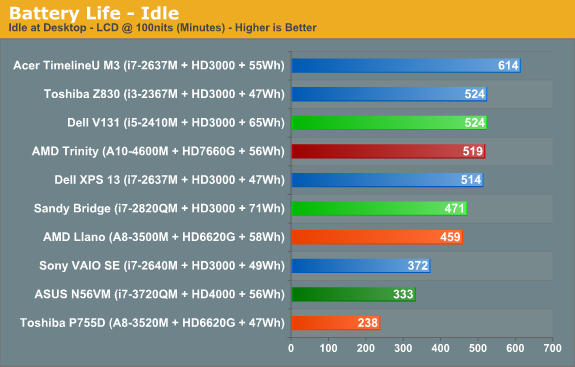
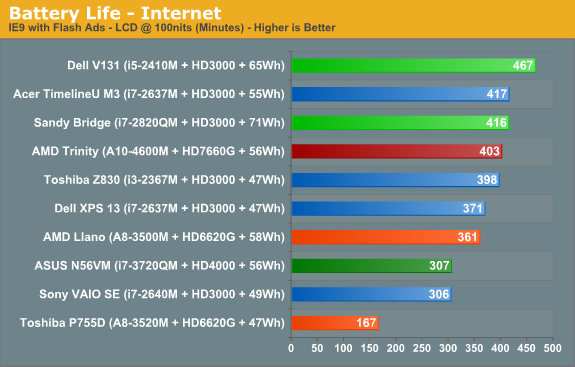
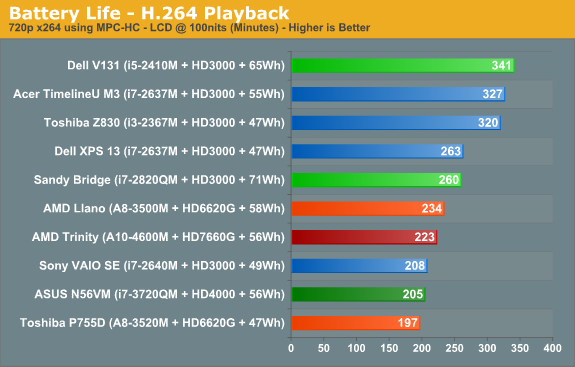
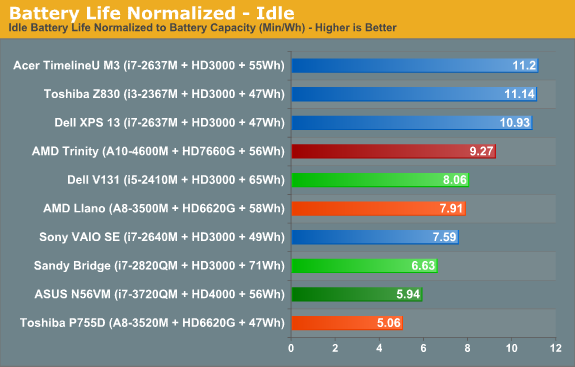

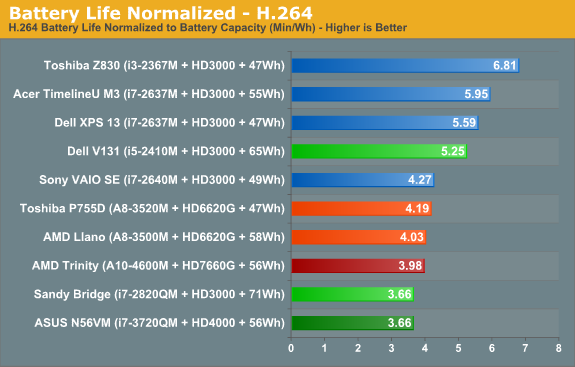
With a similar capacity battery to the original Llano laptop, and the same size 14” panel, Trinity comes out of the gates and posts two clear wins: idle battery life and Internet battery life are both up substantially relative to Llano. In fact, looking at the normalized charts, the only laptops that can consistently beat Trinity are found in Sandy Bridge ultrabooks—we won’t even bother discussing Atom or Brazos netbooks, as they’re competing in a completely different performance bracket. In something of a surprise, H.264 battery life doesn’t see the same benefit unfortunately, and it’s the one discipline where Llano still holds on to a slight lead over Trinity. Sandy Bridge meanwhile has always done very well in H.264 battery tests, and we see that with the Vostro V131 posting a normalized score that’s 30% better than Trinity and Llano. Of course, on the other end of the spectrum we have Ivy Bridge; we’ve only looked at one Ivy Bridge laptop so far, but if the pattern holds than Ivy Bridge will generally be a moderate step back in battery life relative to Sandy Bridge, giving AMD an even larger lead in this area.
We also performed a few other tests that we won’t present in graph form. One set of tests we alluded to earlier: the charts show Trinity with a Samsung 830 SSD, but we also ran tests with an Intel 520 SSD. Idle battery life dropped to 476 minutes (an 8% decrease), Internet battery life checked in at 371 minutes (down 8% again), and H.264 battery life stayed nearly the same at 217 minutes (down less than 3%). If battery life is one of your primary concerns, remember: all SSDs are not created equal!
Another test that we ran is simulated gaming; we looped the four graphics tests in 3DMark06 at 1366x768 until the battery ran out. We’ve run this same test on quite a few other laptops, and Llano initially looked to be far and away the best solution. Later, we discovered that when we tested Llano we were letting the GPU run in power saving mode—basically half the performance you’d get compared to being plugged in. We retested and measured 98 minutes, so the extra graphics performance comes with a heavy cost. We only tested Trinity (and Ivy Bridge and Sandy Bridge) using higher performance graphics settings, and this is one more area where it scores worse than Llano: Trinity managed just 77 minutes. That’s about the same as Ivy Bridge and Sandy Bridge (79 and 73 minutes, respectively), so if you’re after better gaming performance while running off the mains, you might need to keep looking.
Before getting too carried away with the above results, you still need to consider how important battery life is for your usage model. Some people travel a lot and like to go all day without plugging in; others will go from place to place and plug in whenever they’re not on the go. If you fall in the latter category, battery life isn’t usually a problem with any decent laptop, while those looking for all-day computing will definitely want as much mobility as possible. Ultimately, battery life is a factor of battery capacity as well as power optimizations done by the OEMs. We’ve seen battery life improve by as much as 50% when comparing two otherwise similar notebooks, but at least AMD’s reference platform for Trinity delivers a great starting point.
Temperatures and Acoustics
One other item we wanted to quickly touch on is system temperatures. We typically use HWMonitor and check temperatures of laptops under idle and load conditions. We did this with Trinity as well, but unfortunately the current version of HWMonitor doesn’t give us a lot of information. The only temperatures it reports are from the SSD and the HD 7660G graphics—there’s nothing about CPU core temperatures. That means we can’t provide much detail, other than to say that load temperature on the GPU topped out at 71C during extended testing, while the idle temperature was 39C. As usual, temperatures and noise levels go hand in hand, and the low 71C maximum GPU temperature matches up nicely with noise levels that never got above 37dB. It’s not the quietest laptop we’ve ever tested, and surface temperatures can get a little warm, but overall Trinity looks to be a good balance of performance and power requirements, which means quiet laptops are definitely possible.










271 Comments
View All Comments
texasti89 - Tuesday, May 15, 2012 - link
A10-4600M's TDP = 35W
I7-3720QM's TDP = 45W
I'm pretty sure that Intel's 22nm is more power efficient that any 32nm process available in the industry. The efficiency of Intel GPU architecture is what makes their graphic solution appears to be comparable to AMD fusion parts.
Lolimaster - Tuesday, May 15, 2012 - link
As obviously with the biased reviewers.Yeah GJ. Compare a top of the line UBER-expensove IB quad core with the highest TDP and the highest frequency vs A10 Trinity wich costs 3times less(if not more) thant that i7 3720QM.
HD4000 performance is craptastic. Don't fool people with biased comparisons, at medidum detail and low res, cpu take advantage. For mobile each Mhz towards the 3Ghz and above improve performance.
BUT WE ARE TALKING ABOUT AN i7 IB 3x times MORE EXPENSIVE than Trinity with WAY HIGHER MHZ. It's not the pathetic HD4000 that is shining is just the cpu, you can put an HD6450M and it will appear "faster" than Trinity if you pair with a high end expensive cpu.
It's like the moronic reviews with a i7 3770K ($300+) vs A8-3870K ($120).
Everyone knows that the real competion are the dual core i5 and similar price.
And again, medium details when APU's prooved to offer high quality in most games.
JarredWalton - Tuesday, May 15, 2012 - link
http://www.anandtech.com/bench/Product/600?vs=580I've got Mainstream and Enthusiast performance results in there for the games, but there's not much point in running games at 1600x900 High settings at <30 FPS is there?
I have a whole section stating why we're including the systems we're including. Are you seriously delusional enough to suggest that we not show HD 4000 performance? There are no other HD 4000 results available for the time being, so either I use the i7-3720QM or I omit Ivy Bridge entirely. For you to imply its inclusion (with the note--italicized even!--that "these two laptops do not target the same market") is somehow biased is in fact far more bias than anything I've shown. And the pricing is twice as high for the ASUS system, not three times -- in fact I'd guess the Trinity laptop would be closer to $800 as configured, since it has Blu-ray and an SSD.
What's more, throughout the review, I've included dual-core i5-2410M results and discussed how AMD's Trinity stacks up. Judging by Sandy Bridge, dual-core Ivy Bridge will be within 10% of the quad-core scores for gaming--it's not like many games can use more than two CPUs, and so it's really just a matter of the HD 4000 clocks being slightly lower on i5 models. You fail to grasp this fact with your ranting and biased outlook, unfortunately.
In other words, I think your "moronic reviews" comment reflects your reading comprehension skills--or lack there of. Better luck next time. You might want to sign up for the remedial math and basic reading classes at the local community college.
kyuu - Tuesday, May 15, 2012 - link
"I've got Mainstream and Enthusiast performance results in there for the games, but there's not much point in running games at 1600x900 High settings at <30 FPS is there?"Is that that the FPS you get? Did you actually test this or just assuming? Also, you can run 1600x900 without automagically turning up the detail settings to High at the same time. I, for one, am interested to see if the performance advantage increases over Llano/HD4000 when you shift more of the burden to the GPU side. At x768, it seems like the CPU would still be handling enough to make the CPU a substantial bottleneck.
JarredWalton - Tuesday, May 15, 2012 - link
Yes, the scores in Mobile Bench are all actually tested -- including the 5 FPS average score of Trinity at 1920x1080 with 4xAA in Battlefield 3. (Yes, watching that made me feel a bit nauseous....) I could test 1600x900 at medium detail, but I don't expect any major changes from what the existing scores show.Denithor - Tuesday, May 15, 2012 - link
Actually those facts are very interesting to some of us! It lays out what the system can/cannot handle in practical terms. Now, granted, BF3 @ 1080p/4xAA is kinda an obvious fail scenario, but 1080p medium detail might be good to know.One real question that I haven't seen mentioned yet - how come there were no Intel cpu + nVidia gpu systems included in this testing? That seemed like a no-brainer to me...
JarredWalton - Wednesday, May 16, 2012 - link
I thought the Acer TimelineU was a good choice. The only other recently tested laptops with Intel + NVIDIA are the Razer Blade (if people complain that N56VM is too expensive, what would they say about a $3500 laptop!?) and the Alienware M17x R3 (completely different class of hardware and again over $2000). The others like Dell XPS 15z came before we changed our game list, so we don't have some of the results for such laptops.vegemeister - Tuesday, May 15, 2012 - link
CPU speed doesn't become significant at low resolution because the resolution is low, but because the frame rate is high. The CPU must create the scene to be rendered at much higher temporal resolution.bji - Tuesday, May 15, 2012 - link
I think this was a well written article and that you laid out the facts about as clearly as could be laid out. I agree that Lolimaster has poor reading comprehension and needs some remedial education.raghu78 - Tuesday, May 15, 2012 - link
OEM laptop pricing is what changes the discussion. Also the sandybridge stock clearing firesale is a crucial factor. Given that core i7 2630qm with nvidia GT 555M is at USD 800 and entry level core i5 laptops at USD 550http://www.newegg.com/Product/Product.aspx?Item=N8...
http://www.newegg.com/Product/Product.aspx?Item=N8...
The A10 trinity laptops need to come at USD 600 with a max of 650 for the best designs, with the A8 at 500- 550 and the A6 / A4 at USD 400 - 450.Then they can clearly avoid competing core i7 with discrete GPU configs and be considered good alternatives for the low end Intel core i5, core i3 and pentium/ celeron dual cores with crappy intel HD 3000 graphics. Not to forget the the GPU drivers advantage which AMD has, very good image quality and a rapidly growing GPU accelerated apps ecosystem.